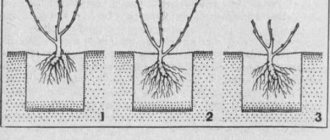Selecting a location
Grapes are a heat-loving crop, so you should choose a site where they will be protected from the cold. Less whimsical are maiden (ornamental) grapes, which are used in landscape design.
The best place for planting is well-lit and protected from the wind areas near the southern or western walls of a house or outbuildings. It’s good if the plant is painted dark, so it heats up better and transfers heat to the plant.
You should not plant grapes in the shade or close to tall trees.
Attention! When placing grapes near the wall of a building, it is necessary to retreat 80 cm from it so that water from the roof does not flow onto the bush.
In regions with a harsh climate, where there is not enough light and heat, it is better to grow grapes in a greenhouse.
What affects the optimal distance between bushes
Grapes are an unpretentious plant, however, to obtain a high yield, it is necessary to follow a number of agrotechnical practices. The following factors can influence the distance between grapes when planting:
- grape variety - low-growing, medium-growing and spreading;
- ripening periods of varieties - it is necessary to select varieties taking into account climatic conditions. For example, in the central region of Russia, late varieties do not have time to ripen - there are not enough sunny days. Therefore, it is recommended to use early and mid-season varieties;
- vine planting scheme;
- landing place;
- plant pollination - there are male, female and self-fertile grape varieties. For normal cross-pollination, it is recommended to alternate varieties with male and female flower types. Beginner gardeners are recommended to use self-pollinating species.
- climatic conditions - it is necessary to pay attention to the frost resistance of the variety. Covering varieties are recommended to be planted near outbuildings to provide additional wind protection. Inexperienced gardeners should choose frost-resistant varieties;
- volume of planting material;
- type of trellis.
The distance between grape seedlings during planting significantly affects the crop yield. Incorrect placement of bushes, when they grow, can negatively affect the productivity of both the grapes themselves and the neighboring crops. Moreover, this can make it difficult to care for plants: processing, harvesting, pruning, etc.
The distance between grape seedlings when planting must be planned in advance. On the one hand, you need to plant the required number of plants, and on the other hand, you need to ensure that these plantings develop in comfortable conditions and do not interfere with other crops. In general, when planning planting density, you can take the distance between plants as 1.5 to 3 meters .
Recommendations for choosing a place to plant grapes
Grapes are a crop that loves sun, warmth and air. Based on this, when choosing a landing site, you need to consider the following:
- The crop should be planted in well-lit areas warmed by sunlight. If you plan to plant plants near a house, outbuildings or fences, you need to choose the sunniest side;
- soil - the most suitable soils for this crop: sandy and sandy loam soils with good breathability;
- groundwater – groundwater located close to the surface can lead to the death of the planting. Moreover, such soil freezes strongly in winter. Therefore, it is recommended to plant by making a special ridge of soil, laying a sand-gravel mixture in the planting holes, and constructing drainage ditches along the perimeter of the site;
- tall fruit trees, in order to avoid shading of the grapes, should be located no closer than 3 meters;
- To avoid soil erosion, when planting on sloping areas, it is advisable to place rows across the slope.
Deadlines
Spring and autumn are equally suitable times for planting grapes. The planting technique is practically the same in these seasons. The only difference is that in the fall you need to take care of covering the seedlings so that they do not die during wintering.
From late April to mid-May, lignified annual seedlings are planted. At the end of May and beginning of June, vegetative green seedlings can be planted.
In autumn, planting is carried out from October until the onset of frost. Lignified seedlings are planted in the ground using the same method as in the spring.
Plot
14 votes
+
Vote for!
—
Vote against!
When planning to plant grapes on your site, it is worth considering a number of features of this process. After all, in order to harvest the first harvest in just a few years, it is necessary not only to choose a variety that is ideal for the area, but also to carry out proper care, taking into account all its features.
Where is the best place to plant grapes?
When choosing the most suitable place for planting grapes, you should focus not only on the aesthetic appearance of the garden, but also on the needs of the plant for its most comfortable development, and most importantly, productivity. Therefore, before purchasing seedlings for your future vineyard, you should find out a few facts about it.
- Grapes are a perennial plant, so you need to be very responsible, and most importantly in advance, to select a planting site for them. It is important to take into account the biological characteristics of the selected variety in order to further obtain maximum yield.
- Another fact worth knowing about grapes is their aversion to shaded areas. Taking this into account, you need to choose the southern or western side of the site, and also avoid planting next to tall trees.
- Almost all grape varieties are heat-loving and do not tolerate temperature changes during the winter season. Therefore, it is necessary to carefully select a place on the site where it will be protected from strong winds and low temperatures. In this case, the most suitable location for the plant would be near the walls of the main building or outbuildings. The thing is that during the day the walls warm up to a certain extent from the sun, which allows them to give off excess heat to the vine at night. In addition, this arrangement significantly accelerates the ripening time of berries. If the question is which grapes are best to plant, then the choice should be given to zoned seedlings.
- As for the need for a certain type of soil, in this regard, grapes are completely unpretentious. But there is still a certain nuance - seedlings planted in fertile but rocky soil differ in yield. The drainage qualities of such soil prevent stagnation of moisture, which contributes to the oversaturation of the soil with lime and salts. All this can have a negative impact on the grapes.
The best time to plant grapes
- The autumn and spring seasons are equally suitable for planting young grape seedlings in the ground. From the end of April until mid-May, annual seedlings with already lignified trunks are planted. But from the end of May and throughout June, you can plant green vegetative grapes.
- As for the autumn planting of seedlings, it is usually carried out from October until the onset of the first frost. The technique is practically no different from the spring season, with the exception of careful protection of young grapes from sudden temperature changes. As a rule, for this purpose the grapes are covered with peat, pine needles or sawdust.
How to plant grapes at home
Preparing seedlings for planting
Of course, only healthy grape seedlings are suitable for planting. How can I check this? There are several factors that indicate quality.
- The root cut of a young seedling must be white. Its brown tint indicates the unsuitability of the escape.
- The annual shoot should be mature with a bright green cut.
- A viable seedling is distinguished by dense buds that do not fall off with a light touch.
These rules are also suitable for planting virgin grapes, although they are more unpretentious.
Before planting grapes with cuttings, it is necessary to prepare them for planting:
- The cuttings are cut from below so as to leave 1 cm before the first bud and about 2 cm above the top;
- over the next 24 hours, the seedlings must be soaked in an aqueous solution with a tablespoon of honey to further stimulate growth;
- After the soaking process, the cuttings are thoroughly dried and paraffinized. To do this, you will need a liter container in which 15 grams of wax and resin, 300 grams of paraffin and water are mixed. The mixture must be heated, stirring thoroughly. The cuttings can be waxed separately or in several pieces; to do this, they are dipped with the top part into the prepared mixture, and then into a container with cold water. During the procedure, no more than 6 cm of grape seedlings are processed;
- In addition to proper pruning and processing, young grape seedlings also need a preliminary hardening procedure before directly planting in the ground. Otherwise, they may suffer significant damage in direct sunlight;
- For one week, vegetative seedlings are kept under a canopy or in the dense shade of trees. Then about 10 days under natural sunlight. As for seedlings that were grown in conditions of insufficient lighting and in violation of the temperature regime, the acclimatization period for them is extended by 1.5 times. Their appearance is distinguished by more elongated shoots, and the leaves are pale green in color;
- young grape seedlings that have not undergone the proper hardening procedure and are planted in open ground in early spring react to such conditions as if they were responding to the early onset of autumn. The result is that growth stops, and the growth takes on a woody form - in this way the seedling prepares for the expected winter. This is not critical for the plant. Since closer to mid-June, these seedlings resume active growth and development.
Planting grapes in black soil and clay
The procedure for planting grapes in black soil and clay.
- A recess is prepared for the lignified seedling: 80 cm deep and 80 cm wide.
- The bottom is covered with a nutrient layer, the thickness is 25 cm. Its composition includes 10 buckets of humus mixed with fertile soil. After thorough compaction, this layer is covered with mineral fertilizers in the ratio: 300 grams of potassium fertilizers, the same amount of superphosphate per 3 liters of wood ash. This layer is also mixed with soil and lined with a thickness of 10 cm. The next 5 cm are lined only with soil. Upon completion of all manipulations, a recess of 50 cm should remain.
- The next step is to form a small mound in the center of the depression. A seedling is inserted into the middle and the roots are evenly distributed. The grapes are covered with fertile soil (chernozem or clay) to the growth level. Seedlings germinated from shortened cuttings are planted vertically, but specimens longer than 25 cm should be planted at a slight angle.
- After the seedling is installed, and all previous layers have been carefully compacted, the soil is watered with two to three buckets of water. After partial drying, the top layer is slightly loosened to a depth of about 10 cm.
- Subsequently, the grapes are watered two more times with an interval of two weeks. Then the soil is loosened and mulched again.
Advice: if you need to plant wild grapes (maiden grapes), then everything is much simpler here. It takes root best in the fall. It is enough to cut the vine of any length without roots. Lay it horizontally on the ground and dig it in with fertile soil so that all the shoots (leaves) are on the surface. In the future, an independent vine will begin to grow upward from each such leaf. In autumn there is enough rain, so watering should be done only as needed.
Planting seedlings in sandy soil
What is the difference between planting grapes in sandy soil if we compare this process, for example, with clay or black soil?
- The thing is that at low temperatures, sandy soil freezes faster and more strongly, and in the summer, accordingly, it warms up excessively. In addition, this type of soil practically does not retain moisture and nutrients, unlike fertile soil.
- All these factors must be taken into account in the process of planting grapes. Thus, the recess for the seedling should reach a meter in depth. And to maintain humidity and avoid loss of nutrients, a particularly dense layer is laid at the bottom of the pit. It is formed from clay soil to a height of at least 20 cm. Fertilizers and a nutrient mixture are poured on top of it (height - 25 cm).
- The most acceptable depth for planting seedlings in sandy soil is 60 cm. Caring for grapes will consist of regular watering, which will need to be done at intervals of seven days, 4 full buckets of water.
Planting vegetative seedlings
- The hole in the soil is prepared in the same way as when planting a lignified seedling. The difference lies in the depth of the hole; it should be 25 cm on clay and chernozem soil and about 20 cm on sandy soil. All layers are thoroughly compacted and watered with 2-4 buckets of water at weekly intervals.
- After the soil shrinks, it is necessary to make a depression of 55 cm on clay or chernozem soil and 65 cm on sand. The seedling that has undergone the hardening procedure is carefully removed from the planting container and, together with the soil, is placed at the prepared planting depth. The intermediate distance is filled with fertile soil, compacted and watered with one bucket of water.
- Having finished planting, a wooden peg is installed next to the vegetating sprout to further support the grape seedling.
Important: seedlings that have not undergone acclimatization are recommended to be shaded using a protective screen. To do this, it will be sufficient to place tree branches or sheets of plywood for 10 days on the south side of the planting.
- In the first year, you need to leave only one shoot on the seedling, carefully remove the rest and tie the grapes to a peg.
Plant grapes in spring
- Spring planting of grapes ensures that by the beginning of cold weather, they will gain the necessary power and be sufficiently saturated with nutrients. This guarantees the young seedling resistance to low temperatures.
- Preliminary soil preparation has a beneficial effect on the development of young seedlings. Thus, if the holes for grapes are prepared in advance - in the fall, then by spring the ideal basis for planting, saturated with natural fertilizers, will be ready.
- Many grape varieties are capable of producing a small harvest in the second year. But this is only in the case of spring planting. Fruiting of autumn seedlings is usually delayed by one year.
- Another positive point is the favorable temperature regime of the spring season. After all, in the fall the first frosts can not only damage the young shoot, but also freeze the soil.
But among so many advantages, there are a number of nuances that should be taken into account when choosing the spring season for planting grapes:
- lack of moisture. During this period, additional watering will be required, which is provided naturally in the autumn;
- lack of nutrients in the soil. This is especially true in early spring, when they need to be compensated for with additional flooring of moss, sawdust and humus;
- high-quality grape seedlings go on sale in the autumn, which is why there is a high probability of acquiring frozen samples in the spring.
And yet, spring is considered a favorable season for planting grape seedlings. Only one question arises: is it possible to plant in the ground at any time? No, you really need to choose the planting period, taking into account both the needs of the seedling and the temperature regime.
- The most optimal temperature is above 15°C. In addition, soil temperature indicators are also important, because they must reach at least 10°C. It is during this period that the best vegetation of the seedling occurs. By month, this time interval will vary by region. Since in one the last frosts end before the end of March, and in the other, nighttime temperature changes occur until mid-April.
- In addition to the temperature regime, it is important to take into account the type of seedling: vegetative or woody. The first option is available for sale in small containers with soil. Such seedlings are distinguished by the presence of young shoots with leaves. Favorable landing period: from mid-May to the end of June. But the woody seedling is particularly vital, as it has a formed root structure and buds. Therefore, even with early planting, for example, in mid-April, it will already be able to withstand changing climatic conditions.
How to plant grapes in the fall
There are also many peculiarities in planting grape seedlings in the autumn. The advantages include the following factors.
- The level of humidity at this time of year has a positive effect on the growth and formation of young shoots of grapes. Additional watering is only required in the first few weeks after planting.
- Autumn seedlings tend to develop earlier and begin to bear fruit.
- But the main disadvantage is the fact that it is not easy for young seedlings to withstand frosts and gusty winds, even with proper shelter.
- When choosing a period for planting grape seedlings in the ground, it is worth considering not only the advantages and disadvantages of each of them, but also the characteristics of the selected variety.
Plant grapes video
General rules for planting grapes
- The most important thing for the development of grapes is the right soil. Fertile lands: black soil and light soils are exactly what seedlings need.
- In addition, it is necessary to take into account the level of groundwater. If their fluctuation reaches a depth of 1.5 meters, then it is imperative to equip a drainage system.
- An important point is fertilizing the soil with mineral additives and timely watering.
- Planting grapes involves a placement scheme for seedlings in which they receive the maximum amount of lighting and do not disturb the mutual growth of the root system.
- When planting grape seedlings on a site, it is necessary to maintain a distance of 2 to 2.5 meters.
- When placing seedlings near buildings, the distance should be at least 0.5 meters.
- The distance from dense and tall trees and shrubs is 0.5-0.7 meters.
How to plant grapes correctly. Common Mistakes
- Planting seedlings with a weak root system - they may either not take root at all or be delayed in development. In addition, such shoots are unlikely to produce a good harvest.
- Purchasing seedlings of an unknown variety may result in the need to uproot and purchase a new one. For seedlings that do not correspond to the climatic zone, the fruits do not have time to ripen during the season, so replacement will also be required in the future.
- A common mistake is to plant grapes near trees and in the north side near buildings on the site. In this case, the plant will spend all its energy on growth, the harvest will be small and it will be located on the upper shoots.
- When forming a shallow hole for planting, you need to know that this will limit the seedling in nutrients and affect its development.
- Excessive deepening will slow growth due to exposure to low temperatures in deep soil layers.
- But shallow burial will affect the seedling’s water consumption and will make it impossible to cover the vine for the winter.
- Thickening of the grape planting will lead to an increase in the number of fungal diseases, in addition, the seedlings will compete for water consumption and lighting.
- Planting only female varieties without potential pollinator varieties can lead to crop reduction. It is recommended to plant one pollinating bush for every six “female” bushes.
Planting young grape seedlings is a rather labor-intensive process. It is important not only to select shoots that can withstand climatic conditions and soil properties, but also to carry out high-quality preparation for planting. Compliance with all the nuances guarantees good indicators of development and fruiting of the future vineyard.
Priming
It is believed that grapes are undemanding to the soil and can grow in almost any area except swampy and too wet ones.
It feels best on light fertile soils, as well as on black soil. Sandy and rocky areas where moisture does not stagnate are well suited for it. The fact is that with excess water, the soil is saturated with salts, which harms the root system of the grapes.
Peat and clay soils are considered unsuitable, and in this case, when planting, you need to put broken brick, expanded clay, crushed stone, etc. on the bottom of a dug hole.
Grapes have a root system deep in the ground, so the groundwater level should be at least 1.5 meters.
Why is grape thickening dangerous?
Placing plants too compactly can lead to reduced yields. Thickening of plantings leads to:
- lack of lighting;
- lack of nutrients;
- rapid spread of fungal and infectious diseases;
- poor development of the root system;
- waterlogging of the soil;
- to a more labor-intensive process of processing and harvesting.
Thoughtful planning of the site can not only contribute to obtaining a good harvest, but also improve the dacha area. An arched, decorative trellis, even with wild grapes, can hide the dacha from prying eyes and give it a southern flavor.
Scheme
The distance between grape bushes depends on the variety and characteristics of the bush. With a short vine this interval should be 2 m, with a long vine - 3 m.
The grape planting scheme must be carefully planned in advance, since transplants have a bad effect on the plant
The rows should be directed from north to south. The distance between rows is from 2 m.
On a note! In the spaces between the rows of grapes, you can plant greens, such as parsley.
Planting cuttings in open ground
How to calculate the distance between two bushes? A winegrower with experience in planting his own vineyard or a beginner needs to take into account that planting planning concerns not only the length of the planted row, but also the distance between individual bushes. Why is it so important to arrange chibouks in a certain demarcated area? The distance between the bushes affects the technical and economic performance of grapes. Correcting mistakes made during landing is difficult, if not impossible. Incorrect placement of seedlings that grow harms not only the grapes, but also neighboring crops in the garden or on the land. When planting, the density of the future vineyard is taken into account in advance.
Experienced winegrowers purposefully influence the quality and quantity of the harvest. Simple manipulations significantly save time for caring for bushes and increase the fruitfulness of all grapes. In recent years, the theory of the dependence of the amount of harvest on two indicators of the vineyard - the number of eyes on the bush and the location of the bushes - has become increasingly popular among breeders. Maximum growth vigor is achieved through timely pruning of the vine and proper planting of the stems. How to grow grapes correctly for a large harvest? The vigor of bush growth depends on the following factors:
- the location of each seedling;
- pruning;
- grape sort;
- fertilizer and watering.
Grapes grow best when they grow in sequentially planted bushes. It is recommended to plant the vine on well-fertilized soil with prepared, moistened holes. How to properly place chibuki?
Planting depth
When planting, it is important to correctly determine the depth, which depends on the type of soil and the level of groundwater.
If groundwater is close to the surface - above 1.5 m, good drainage must be arranged. Another option is to make a mound for planting bushes. It is necessary to place slate at the bottom of the planting hole so that the roots grow in breadth and not in depth.
The dependence of planting depth on soil type is presented in the table:
| Soil types | Planting depth in m |
| Sandy | 0,55-0,6 |
| Sandy loam and loamy | 0,5-0,55 |
| Clay and black soil | 0,4-0,45 |
The distance between the grape bushes on the arch. Vertical cordon
The most popular method for forming grapes on an arbor is a vertical cordon. Mainly used for vigorous, frost-resistant varieties that do not require winter shelter.
Let's look at how to properly prune arched grapes during the first few years of their life:
- When planting and in the first year, only a vertical trunk (trunk) is formed in the bush, leaving only 2 shoots. They must be secured in a vertical position.
- From the second year, we begin to form “sleeves”. We take as a basis the strongest shoot that grows upward. We cut it off above the attachment point. The second one is deleted.
- Further pruning will involve the formation of fruit-bearing links.
- On a fixed branch, we allow only the top 3 arrows to develop, which need to be tied vertically. In the fall, we cut off the unripe green part of them.
- Next spring, one powerful shoot is attached vertically and cut off in the place where the next tier will be laid. The distance between the tiers should be 30-60 cm. We attach the two remaining branches to the lower horizontal support. This will be the first tier.
- We again leave the top three arrows on the vertical vine. And on the horizontal ones we don’t touch anything.
- The remaining tiers are formed in the same way.
You can create high-standard cordons when the first tier of sleeves is placed at a height of 1.2-1.5 m. In this case, in the second year, the most developed shoot is shortened by 3-5 buds. Over the summer, 2-3 arrows will grow on it, which, as they grow, are tied to a support. The next year, we tie up one shoot that has grown to the supporting horizontal line and cut it off above the attachment point.
Planting material
You can purchase planting material in the form of seedlings or cuttings.
A cutting is a piece of woody grapevine without a root system with several buds. Before planting, you first need to form its root system.
Seedlings are young plants with a formed root system, usually two years old. They are usually grown vegetatively - from cuttings, layering or by grafting.
For sale there are seedlings with an open root system and with a closed one, that is, those located in a planting package
There is less hassle with seedlings; if planting rules are followed, amateurs take root in almost 100% of cases. If they are grafted, then the yield and resistance to phylloxera and unfavorable environmental conditions are higher. The main disadvantages are difficulty in transportation and storage.
Cuttings are cheaper, easier to transport and store - they can even be kept in the refrigerator at home. The disadvantages are that seedlings still have to be grown from them, which will require time and labor.
Gardeners do not have a consensus on what planting material is best to purchase. For beginners, it is advisable to buy seedlings from a nursery. Experienced people can plant their own grapes by cuttings.
Selection of seedlings
Planting material - green shoots and cuttings - is chosen carefully; it must be of high quality and healthy.
Features of seedlings:
- if the shoot is annual, then the root system should be white. If the color of the root cut is yellow or brown, the plant will not take root and will soon dry out;
- eyes should look fresh and healthy. If they fall off, the plant is sick.
- The vine and the stem of the seedling must be moist and also release juice. The cut of the vine should be green.
The day before planting, the planting material is placed in a container with water. To do this, remove 3 eyes from the shoots. Growth stimulants and honey are added to the water for better development of seedlings.
Rules for planting seedlings
You can plant grape seedlings in spring or autumn.
Spring planting of seedlings with a closed root system
Most often, beginning gardeners plant seedlings purchased from a nursery in containers (with a closed root system) in the spring.
Before spring planting, grape seedlings should be hardened off. 2 weeks before planting in the ground, they need to be kept in the air daily, starting from 15 minutes and gradually increasing the time by 30 minutes each time. For the first seven days, the vine must be protected from the sun. For the last three days, the seedlings should be constantly outside, unless frost is expected. It should be planted in the ground when the soil has warmed up sufficiently. The best time to plant is morning or evening. You should try to choose a cloudy day for this.
Planting holes should be dug in advance - while the seedlings are hardening off
The width of the square pit is 0.8 m, the depth is approximately the same. Size may vary depending on soil. If the soil is clayey, the hole needs to be enlarged; if it is fertile and loose, the hole needs to be made smaller.
The soil from the hole should be divided into three parts and each should be placed separately - the fertile top layer (about 25 cm), the middle layer and the least fertile bottom layer. Clods of earth need to be carefully inspected and the roots and larvae of garden pests must be removed. Then you need to pour the following components into the hole:
- rotted manure or compost - 2 buckets;
- complex fertilizer (nitroammofoska) – 300 g;
- wood ash – 1.5 kg.
Then you need to pour out the top fertile layer of soil and mix it thoroughly in the hole. After this, pour in two buckets of water. When the soil dries, pour out the middle layer of soil.
When the seedlings are hardened, you can proceed directly to the planting process:
Will grapes grown from seed bear fruit?
- Release the seedlings from the packaging - remove it with a lump of earth.
- Place it in the prepared hole so that the heel (the place where roots form - located approximately in the center of the container) is 35-40 cm below the ground level.
- The eye from which the lower green shoot will form should be 10 cm below ground level - this makes it more convenient to form a bush and cover the shoots for the winter.
- Cover the seedling with the soil of the lower layer 5 cm below the location of the eye, compact it with your hands so that there are no voids, and water it with warm water in the amount of 1-2 buckets. When it is absorbed, fill the hole to the top with soil, but do not compact it so that the soil is loose and allows air to pass through. To prevent moisture from evaporating less and a crust not forming around the plant, it is recommended to mulch the tree trunk circle.
The grapes definitely need support. Pegs or pipes are suitable for young seedlings.
Autumn planting of seedlings with an open root system
Planting of grapes in autumn is carried out from the beginning of October until frost. The main advantage of autumn planting is that the active development of young bushes begins next spring.
This is what seedlings with an open root system look like for autumn planting
How to plant grapes correctly:
- Dig a square hole about 0.8 m wide and deep.
- Divide the soil from the pit into two parts and pour them separately: the top fertile layer is 1/3 of the total soil, the rest is soil.
- Combine the top part of the soil with humus, add 1 kg of wood ash, 0.5 kg of potassium-phosphorus fertilizer and mix thoroughly. Pour the mixture into the hole so that 0.5 m remains to the top and water generously. If the soil settles, add soil to the original level.
- Leave the hole for two weeks so that the earth settles. If you plant grapes in a newly dug hole, they will end up too deep.
- Seedlings need to be soaked for 20 hours before planting. It is necessary to trim damaged roots, as well as those growing on the upper nodes.
- You need to drive a peg into the center of the hole, which will serve as a support.
- Place the seedling in the hole, tie it to a peg and cover it with the remaining fertile soil, then add the rest of the soil mixed with crushed stone or coarse sand.
- Hill up the seedling, cover it with a cut-off plastic bottle and water it with water in the amount of 3 buckets.
Planting methods
Let's look at several popular methods of growing grapes in Russia.
Classical
- The pit, measuring 80x80x60 cm (LxWxD), is prepared in the fall.
Important! The hole for planting grapes is made in advance so that the soil has time to settle. When settling, it can damage the roots.
- The grapes are planted at a distance of 2.5 m between rows and 2 m between bushes.
- Drainage is added to the bottom: pieces of brick and wood, crushed stone. On top there is sand, crushed stone, fertile soil (0.5x1x3 parts). The land is fertilized with mineral fertilizers and ash. Some gardeners recommend throwing half a glass of cereal grains into the hole to saturate the soil with oxygen.
- The cutting is cut from below, placed for a couple of days in a solution with the addition of growth stimulants, then in warm water (5 cm) until the first roots appear.
- The rooted cuttings are placed in a container for seedlings. The drainage level is approximately 2 cm, the soil level is about 6-7 cm. Watering is regular, but not abundant.
- The shoot is pinched, leaving 2 branches.
At the end of spring, the finished cuttings with roots are transplanted into open ground. The ground temperature should not be lower than +15 degrees. The soil is mulched with sand and sawdust.
On the trellis
In the wild, grapes twine around trees; this is their natural state. At home, the plant is provided with support - trellises. Basically, they are support stakes with wire stretched between them. Gardeners prefer to make supports from metal pipes, but wooden ones are also perfect. The diameter of the support is about 10 cm, the wire is about 5 mm. It is advisable that the wire be in a plastic sheath, about half a meter high from the ground.
In the first years, the vine is tied to a support. In the third or fourth year, the vine is tied horizontally, twisting around the wire. The next post is placed at a distance of 40 cm.
On the ridges
This method is ideal for northern regions. It provides the plant with warmth and protection from flooding.
- To create a ridge, dig a trench in a southerly direction, measuring about 10 m in length, 1 m in width, and about 30 cm in depth.
- Fill with soil 30-35 cm above ground level.
- The ridge is mulched, insulated and protected from weeds with heat-supporting material.
- The cuttings are deepened 40 cm into the ground.
A metal tube with a diameter of 30 cm is dug in next to the ridge, through which watering and fertilizing are carried out. Along the ridge you can stick dark bottles with the neck down. They will work like solar panels, giving off their heat to the seedlings.
In the greenhouse
It is a well-known fact that when planted in a greenhouse, grapes ripen faster. Planting is done in a similar way to other methods.
The distance between bushes is at least one and a half meters. Watering is carried out once a week. It is recommended to cover the ground with insulation.
During the period of flowering and ripening of berries, watering is reduced.
In containers
The method is popular in cold regions. Rooted cuttings are initially planted in black plastic bags (35x40 cm) without a bottom. The soil includes humus and deciduous soil (1x3). The packages are placed on a pallet. The roots are dipped in clay diluted with manure and Kornevin. Until the buds appear, the containers are stored in the house. Then they are taken out into the open in the shade, and a few days later in the sun. The plant is planted in the ground after warm weather sets in.
Planting in the Moldavian way
This is an old method, but has not lost its popularity these days. For it, they take a long vine, twist it into a ring, tying it with a rope for strength. This ring is planted in the ground. There should be 2-3 buds left on the surface.
Care is carried out in the classical way. In the fall, a strong bush will develop from this ring, and in a year you will be able to enjoy the taste of the first berries. The advantage of this method is that the vine gives nutrition to the roots, which is why the shoots develop well.
Planting by thickening
In warm areas, when growing varieties, they use the thickening method, that is, up to seven bushes are planted per 1 square meter. The grapes are grown in bush form, the branches are cut short. Supports are not needed in this method. Minus - nearby bushes contribute to the rapid spread of fungal infections, the harvest is less attractive.
Planting grapes from cuttings in autumn
During autumn pruning, you can prepare cuttings, from which you can then grow grapes. Cuttings are made after the leaves fall. This usually happens in October. In cold regions, harvesting begins earlier - in September. In the south - at the end of October or beginning of November.
Cuttings are cut from a healthy fruit-bearing vine that is not damaged
Select central, flat areas of two-year-old shoots. The handle should be hard to the touch and make a characteristic sound when bent. For cutting, use sharp, clean garden shears; the cut should be even, with smooth edges. The thickness of the cuttings is from 5 to 10 mm, the length is at least 20 cm. 2-4 live buds are left on them.
At the end of October - beginning of November, the cuttings are planted in moist soil on a site specially prepared for growing seedlings (school) at a distance of about 15 cm from each other. Then they need to be watered with warm water. A support about 35 cm high should be installed above the school and polyethylene should be stretched to protect it from the cold.
In the spring, when shoots appear and frosts stop, the protective film must be periodically removed to ventilate the seedlings. The shelter can be completely removed when the weather is consistently warm.
Choosing a trellis for grapes
There are single-plane and two-plane trellises
for tying vines.
If you have enough space, then the best option would be to install a two-plane trellis for grapes.
The height of the trellis from ground level to the top point must be calculated: the person who will care for the vineyard, raising his hand up, measures the height from the ground to the palm - this will be the optimal height of the trellis.
For those who do not want to measure, a standard height of 2-2.3 m is suitable.
, you shouldn’t do it higher - it’s inconvenient to trim and tie up the vines.
Summer planting
Planting grapes in summer is a rarer occurrence than in spring or autumn. At this time, there is a large selection of vegetating green seedlings, which are obtained by pruning the vine in spring. They go on sale grown, with a closed root system.
On a note! The main problem that can arise when planting grapes in the summer is hot weather, and, as a result, overheating and drying out of the soil.
The best time for summer planting green seedlings is June
The soil in June does not yet heat up too much. At this time, the seedling already has about 5 mature buds. If the summer is not hot, you can plant grapes in July, but this must be done in cloudy weather.
In the second half of summer, green seedlings are not planted: it is impossible to keep them in a container for so long. Keeping it in a confined space for a long time has a negative effect on the greenery and root system; such a seedling will most likely not take root.
Summer seedlings are hardened off before planting so that they do not burn in the sun on the first day. For 12 days, they are taken outside every day, each time increasing the time spent in the fresh air.
Planting process:
- Two days before planting, the seedlings are watered abundantly. 2 buckets of water are poured into the prepared pits.
- Remove the seedling from the container with a lump of earth.
- Shorten the shoots to 2-3 buds, trim the tendrils.
- A mound is formed in the hole, a seedling is placed on it, sprinkled with earth and watered. You can mulch with humus.
Further care consists of regular watering, which is carried out through a drainage pipe with a diameter of 80-100 mm installed in the pit. In hot weather, the plant must be shaded. At the end of summer, the apical buds of the shoots need to be plucked off to speed up the ripening of the vine by autumn. The grapes are covered for the winter. You can pour a mound of soil over the roots, put a layer of organic matter on top and cover it with film. Or bend the vine to the ground and insulate it with covering material.
At what distance from the house can grapes be planted? Choosing a site for a vineyard
Before choosing a place to plant grapes, any gardener must take into account the number of available seedlings. It is believed that the optimal distance between the vines should be 3 meters. The distance between rows can be 2-3 meters. If the area is too small, then the distance between the bushes and rows is reduced to 2 meters. However, such a distance will limit the possibilities for normal care of the bushes. A prerequisite for successful cultivation is the illumination of the place. The area for the vineyard should not be shaded by neighboring plantings.
A very important role in determining the distance between rows and bushes is played by the grape variety, as well as the type of molding. The widest planting with a distance between rows of 4-5 meters and between bushes of 2 meters or more is used for vigorously growing varieties. This is especially important when grapes grow on fertile soils.
Medium-sized crops using simple trellises are planted with a distance between rows of 2 meters. An interval of 1.5-2 meters is maintained between bushes.
For medium and low-growing varieties on depleted soils, you can maintain a distance of 1-1.5 meters between seedlings and in row spacing up to 1.5 meters. In this case, use a low trellis or use pegs when planting.
With good and fertile soils and the ability to timely fertilize and water grapes with a two-plane trellis, you can maintain a distance between bushes of 1-1.25 meters and between rows of up to 3 meters.
Using high trellises for growing grapes at a level of 3 meters, the crop is planted more densely. It is better to plant grapes at a distance of up to 1 meter. However, they are formed at different heights - in ground and standard formations with a height of 1.2-1.5 meters.
If you plant bushes too close, then caring for them becomes more difficult. A large number of bushes will not give a large harvest if you do not take into account its compatibility with other crops. Trees growing close will draw nutrients from the soil, taking them away from the vine.
Caring for young grapes
Caring for seedlings in the spring involves fighting pests and diseases. To prevent fungal diseases, spray with Bordeaux mixture. For spider mites and grape midges, use laundry soap - 1 piece is required for 1 liter of water. Grape bushes planted in spring must be shaded for the first two weeks to protect them from sunlight. For this, you can use spunbond, shading mesh, and other suitable materials.
After planting, the vine needs to be watered abundantly. The first time is watered directly during planting, then after 10-15 days, then every 2 weeks. If it's hot, they do it more often. The water must stand. One bush requires -5-10 liters.
When planting grapes, fertilizers are applied - they are enough for the plant for two to three years, so there is no need for additional fertilizing. You can apply fertilizer at the end of summer so that the bush is better prepared for winter. You need to prepare a mixture of superphosphate (20 g) and potassium sulfate (10 g) - this amount is calculated for 1 square meter. m.
After autumn planting, the seedling must be prepared for winter
Preparing a pit for grapes
When planting seedlings in a permanent place, preparation of a planting pit is necessary to create optimal conditions for the growth of a young grape seedling.
The size of the planting hole is 0.80 x 0.80 m and 0.7 m deep, however this depends on your capabilities and may vary depending on the fertility of the soil on your site - the more fertile the soil, the smaller the hole size is needed.
The upper half of the soil (fertile layer) is laid to one side and mixed with manure (about 4-5 buckets per hole), add, if available, superphosphate about 100g, potassium fertilizers (potassium sulfate about 2 tablespoons) or 1/2 bucket ash (you can do both).
If you prepare holes in the fall and plan to plant in the spring, or are preparing in the spring for autumn planting, then you can use fresh manure; in other cases, rotted manure. You can replace manure with compost, or, in its absence, with other organic waste - mown grass, food waste, following the same rule as with manure - fresh only if the pit is used after a few months. Mix everything thoroughly.
Then the second half of the soil is removed from the hole (subsoil) and laid separately. After this, a fertile layer with fertilizers is placed at the bottom of the hole, compacted well (trampled down), and then the remaining soil (subsoil) is poured on top and also compacted.
The pit is well watered and left for two to three weeks to allow the soil to settle. The earlier the hole is prepared, the better the soil will be compacted. And the planted grape bush will not “drown” after planting and watering.
Adviсe
Tip 1
Grapes should not be planted spontaneously. Beginner gardeners often make this mistake. If the bushes are not planted pointwise, it is necessary to plan grape plots. It is recommended to group grape varieties according to their purpose, frost resistance, and ripening time.
Tip 2
There is no need to rush into planting young plants in a permanent location. It is advisable to wait for the signal brushes while they grow in the school. In the north, it is better not to plant seedlings in open ground in the first year; experienced gardeners advise keeping them in portable containers, buried halfway into the ground. In the fall they need to be moved to the basement, and in the spring they need to be planted in the ground. Such plants enter the fruiting season faster.
When to plant grapes in spring
Cuttings and seedlings with a closed root system are planted in late spring - early summer , with an open one - at the end of April or early May. When choosing a date, it is important to pay attention to weather conditions and temperature. If it is raining outside or strong winds are blowing, the air temperature does not rise above +5°C, planting is postponed. The air should warm up to +15°C, and the ground - to +10°C.
Favorable days according to the lunar calendar
Using the lunar calendar, gardeners choose those days when planting grapes in open ground will be more successful. It is generally accepted that if you plant a plant on certain dates, it will get sick less and bear fruit better.
The choice of date depends on the rising and waning moon . In 2021, April 30 or May 29 are chosen for planting grapes. Unsuitable dates: May 7, 8, 12, 13, 20, 21.
Attention! Even if the lunar calendar says that April 30 and May 29 are suitable for planting, it is important to pay attention to weather conditions. Air and soil temperatures are the main criteria when choosing a period.
Choosing the right variety
Many beginners miss the moment of choosing a variety, which is a grave mistake. It is important to select a variety according to the weather characteristics in a particular region and personal preferences in terms of not only taste, but also care.
First, it’s worth understanding the ripening time, since different regions have different temperatures, and climatic conditions are not always suitable for the grape variety. The fruit may simply not ripen if there is not enough heat.
Frost resistance and weakness to various diseases are considered important indicators. Choose complex-tolerant grape varieties and various hybrid forms that have the most attractive characteristics. You can learn about the best frost-resistant grape varieties from this article.
Useful tips and tricks
Use trusted suppliers or prepare seedlings yourself. It would be a good idea to prepare the soil for planting in advance in order to deal with other stages of care in the future.
Try to adhere to these rules when planting, so as not to make a mistake with the depth or distance between plants, because this critically affects the growth of the seedling and the future harvest.
Plant grapes at the right time and under the right weather conditions, otherwise a favorable outcome can be forgotten.
Growing grapes is a rather complex and painstaking process that requires careful study and consideration of the needs of a particular variety. However, hard work is rewarded when it comes time to harvest. With the right approach, the quantity and quality of fruits will always be at their best.
0
0
Copy link











